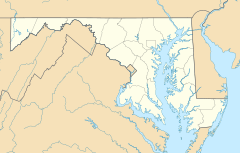Bristol, Maryland facts for kids
Quick facts for kids
Bristol, Maryland
|
|
|---|---|
| Country | |
| State | |
| County | |
| Time zone | UTC-5 (Eastern (EST)) |
| • Summer (DST) | UTC-4 (EDT) |
Bristol is a small community in Anne Arundel County, Maryland, United States. It's called an "unincorporated community" because it doesn't have its own local government like a city or town. Instead, it's part of the larger county.
Bristol is home to the Jug Bay Wetlands Sanctuary, a special nature area. It also includes the historic area of Pig Point, which sits along the Patuxent River.
Contents
Welcome to Bristol, Maryland!
Bristol is a quiet place with a rich history. You can find it in Anne Arundel County, Maryland. It's known for its natural beauty and important historical sites.
Exploring Bristol's History
Bristol has many interesting stories from the past. From old train lines to ancient Native American sites, there's a lot to discover.
Pig Point: A Historic Spot
Pig Point is a very important part of Bristol. It's located right on the Patuxent River. During the War of 1812, this area saw some action. Later, in the mid-1800s, it became the biggest steamboat port in Anne Arundel County on the Patuxent River.
Pig Point is also a major archaeological site. This means scientists have found many ancient tools and items here from early Native American people. These findings date back to the Early Archaic Period, thousands of years ago!
The Chesapeake Beach Railway
In 1899, the Chesapeake Beach Railway was built through the southern part of Bristol, also known as "Pindell." This railway helped people travel and transport goods. Today, you can still see the old ruins of the Pindell Station and its general store.
Another important historical place in Bristol is the James Owens Farm. This farm is so special that it's listed on the National Register of Historic Places. This list includes places across the country that are important to American history. Also in Bristol is the southern end of the Maryland Route 4 highway, known as the Stephanie Roper Highway.
Bristol's Schools and Community
In the middle of the 1900s, Bristol had its own elementary school. It was located in the northern part of the community. In 1953, the school even published a history book about Bristol.
The school grew over time. By 1969, it had about 200 students and four teachers. This growth happened after schools in the county were ordered to become desegregated in 1966. This meant that students of all backgrounds could attend the same schools.



